Financial Analysis: Dexter Plc, Philly Ltd, and Sankrust Ltd
VerifiedAdded on 2020/10/22
|18
|5159
|497
Homework Assignment
AI Summary
This assignment delves into core accounting and finance principles through the analysis of three companies: Dexter Plc, Philly Ltd, and Sankrust Ltd. Part A focuses on Dexter Plc, constructing an income statement and balance sheet for the year 2018, along with detailed working notes for key calculations. Part B analyzes Philly Ltd, calculating break-even points, profit margins, and the impact of sales price changes. Part C examines Sankrust Ltd, calculating net present value, payback period, and accounting rate of return, alongside a discussion of investment appraisal techniques and the role of budgeting in strategic planning. The assignment provides comprehensive insights into financial statement analysis, cost-volume-profit analysis, and investment decision-making.
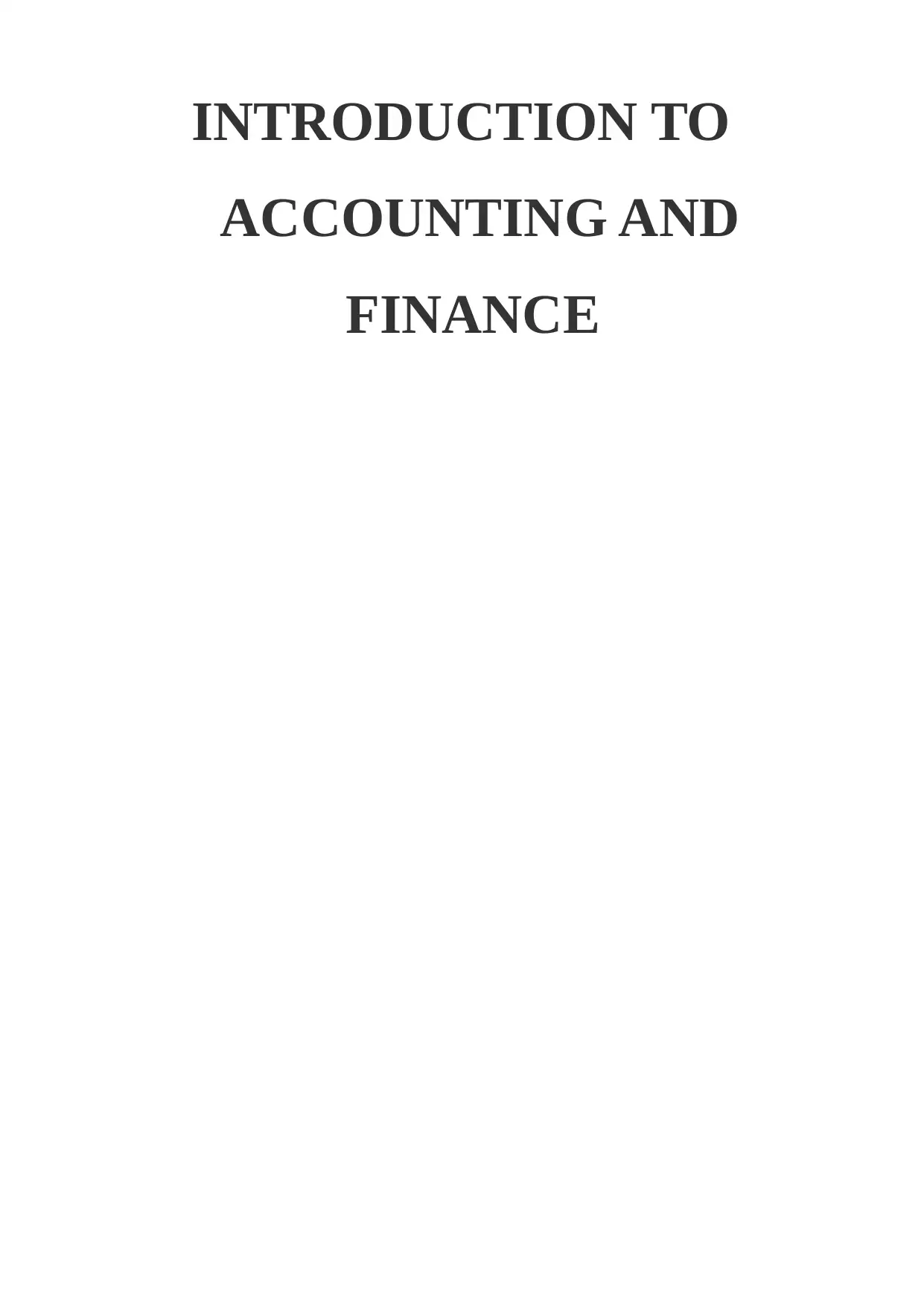
INTRODUCTION TO
ACCOUNTING AND
FINANCE
ACCOUNTING AND
FINANCE
Paraphrase This Document
Need a fresh take? Get an instant paraphrase of this document with our AI Paraphraser
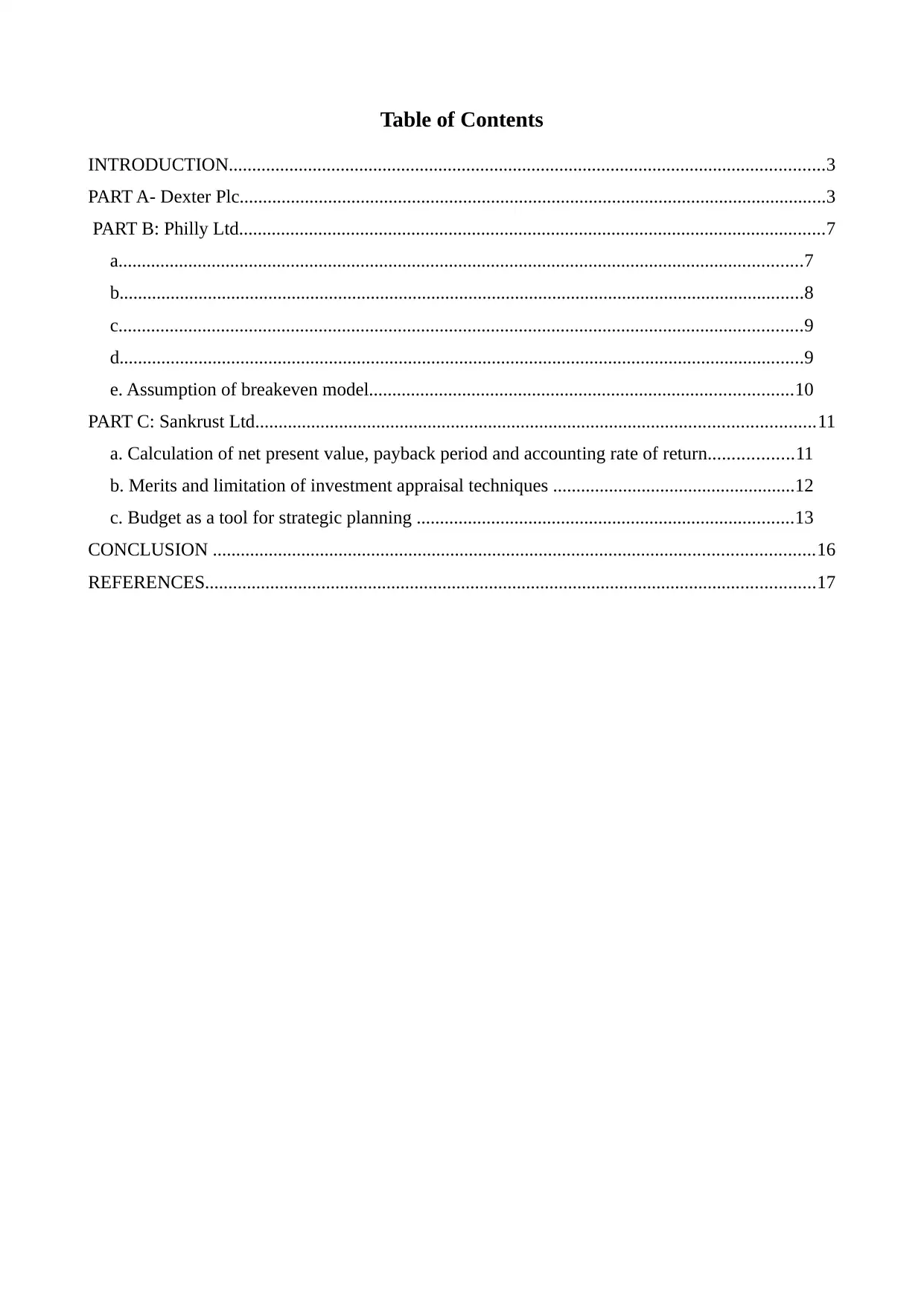
Table of Contents
INTRODUCTION................................................................................................................................3
PART A- Dexter Plc..............................................................................................................................3
PART B: Philly Ltd..............................................................................................................................7
a...................................................................................................................................................7
b...................................................................................................................................................8
c...................................................................................................................................................9
d...................................................................................................................................................9
e. Assumption of breakeven model...........................................................................................10
PART C: Sankrust Ltd........................................................................................................................11
a. Calculation of net present value, payback period and accounting rate of return..................11
b. Merits and limitation of investment appraisal techniques ....................................................12
c. Budget as a tool for strategic planning .................................................................................13
CONCLUSION .................................................................................................................................16
REFERENCES...................................................................................................................................17
INTRODUCTION................................................................................................................................3
PART A- Dexter Plc..............................................................................................................................3
PART B: Philly Ltd..............................................................................................................................7
a...................................................................................................................................................7
b...................................................................................................................................................8
c...................................................................................................................................................9
d...................................................................................................................................................9
e. Assumption of breakeven model...........................................................................................10
PART C: Sankrust Ltd........................................................................................................................11
a. Calculation of net present value, payback period and accounting rate of return..................11
b. Merits and limitation of investment appraisal techniques ....................................................12
c. Budget as a tool for strategic planning .................................................................................13
CONCLUSION .................................................................................................................................16
REFERENCES...................................................................................................................................17
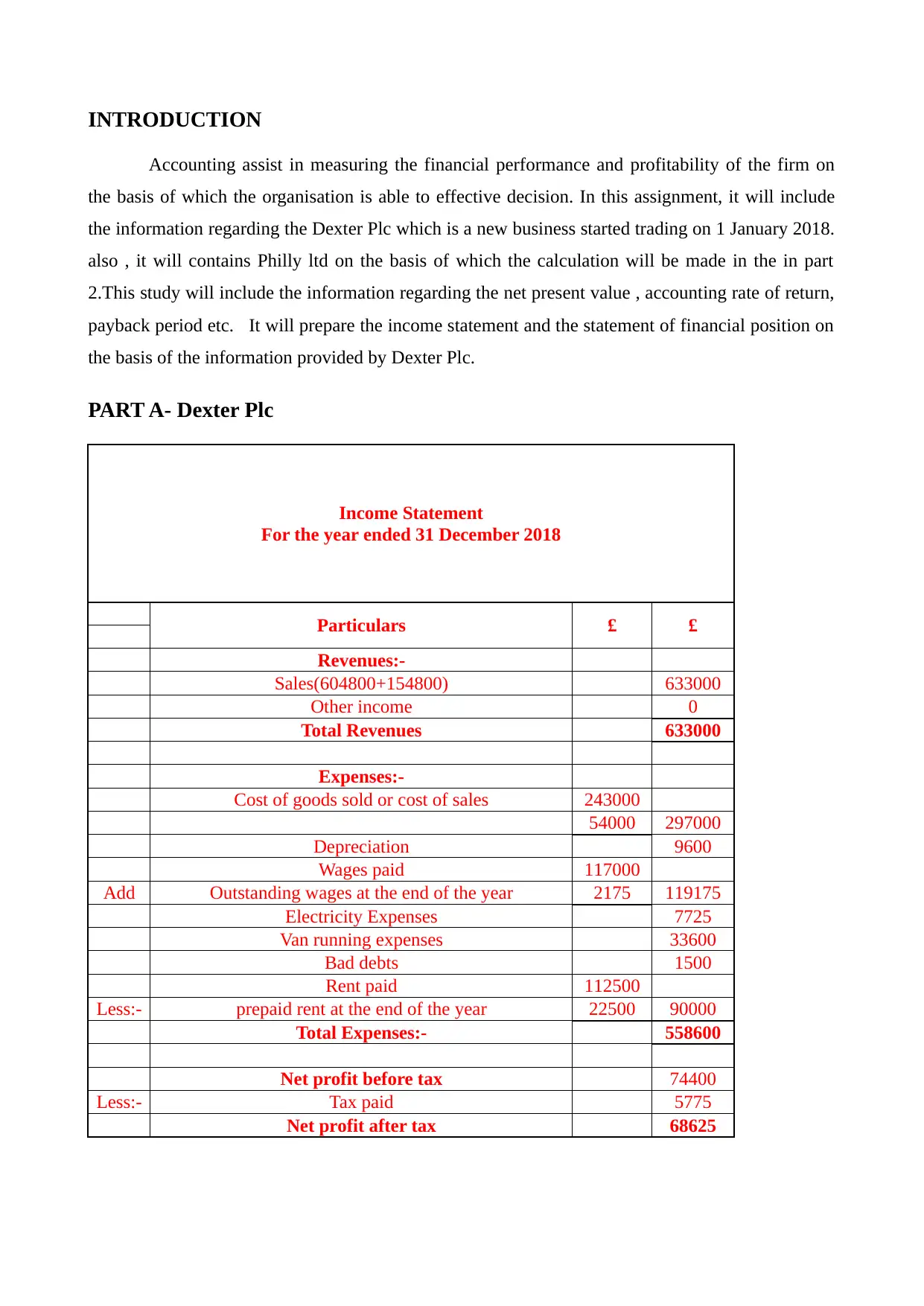
INTRODUCTION
Accounting assist in measuring the financial performance and profitability of the firm on
the basis of which the organisation is able to effective decision. In this assignment, it will include
the information regarding the Dexter Plc which is a new business started trading on 1 January 2018.
also , it will contains Philly ltd on the basis of which the calculation will be made in the in part
2.This study will include the information regarding the net present value , accounting rate of return,
payback period etc. It will prepare the income statement and the statement of financial position on
the basis of the information provided by Dexter Plc.
PART A- Dexter Plc
Income Statement
For the year ended 31 December 2018
Particulars £ £
Revenues:-
Sales(604800+154800) 633000
Other income 0
Total Revenues 633000
Expenses:-
Cost of goods sold or cost of sales 243000
54000 297000
Depreciation 9600
Wages paid 117000
Add Outstanding wages at the end of the year 2175 119175
Electricity Expenses 7725
Van running expenses 33600
Bad debts 1500
Rent paid 112500
Less:- prepaid rent at the end of the year 22500 90000
Total Expenses:- 558600
Net profit before tax 74400
Less:- Tax paid 5775
Net profit after tax 68625
Accounting assist in measuring the financial performance and profitability of the firm on
the basis of which the organisation is able to effective decision. In this assignment, it will include
the information regarding the Dexter Plc which is a new business started trading on 1 January 2018.
also , it will contains Philly ltd on the basis of which the calculation will be made in the in part
2.This study will include the information regarding the net present value , accounting rate of return,
payback period etc. It will prepare the income statement and the statement of financial position on
the basis of the information provided by Dexter Plc.
PART A- Dexter Plc
Income Statement
For the year ended 31 December 2018
Particulars £ £
Revenues:-
Sales(604800+154800) 633000
Other income 0
Total Revenues 633000
Expenses:-
Cost of goods sold or cost of sales 243000
54000 297000
Depreciation 9600
Wages paid 117000
Add Outstanding wages at the end of the year 2175 119175
Electricity Expenses 7725
Van running expenses 33600
Bad debts 1500
Rent paid 112500
Less:- prepaid rent at the end of the year 22500 90000
Total Expenses:- 558600
Net profit before tax 74400
Less:- Tax paid 5775
Net profit after tax 68625
⊘ This is a preview!⊘
Do you want full access?
Subscribe today to unlock all pages.

Trusted by 1+ million students worldwide
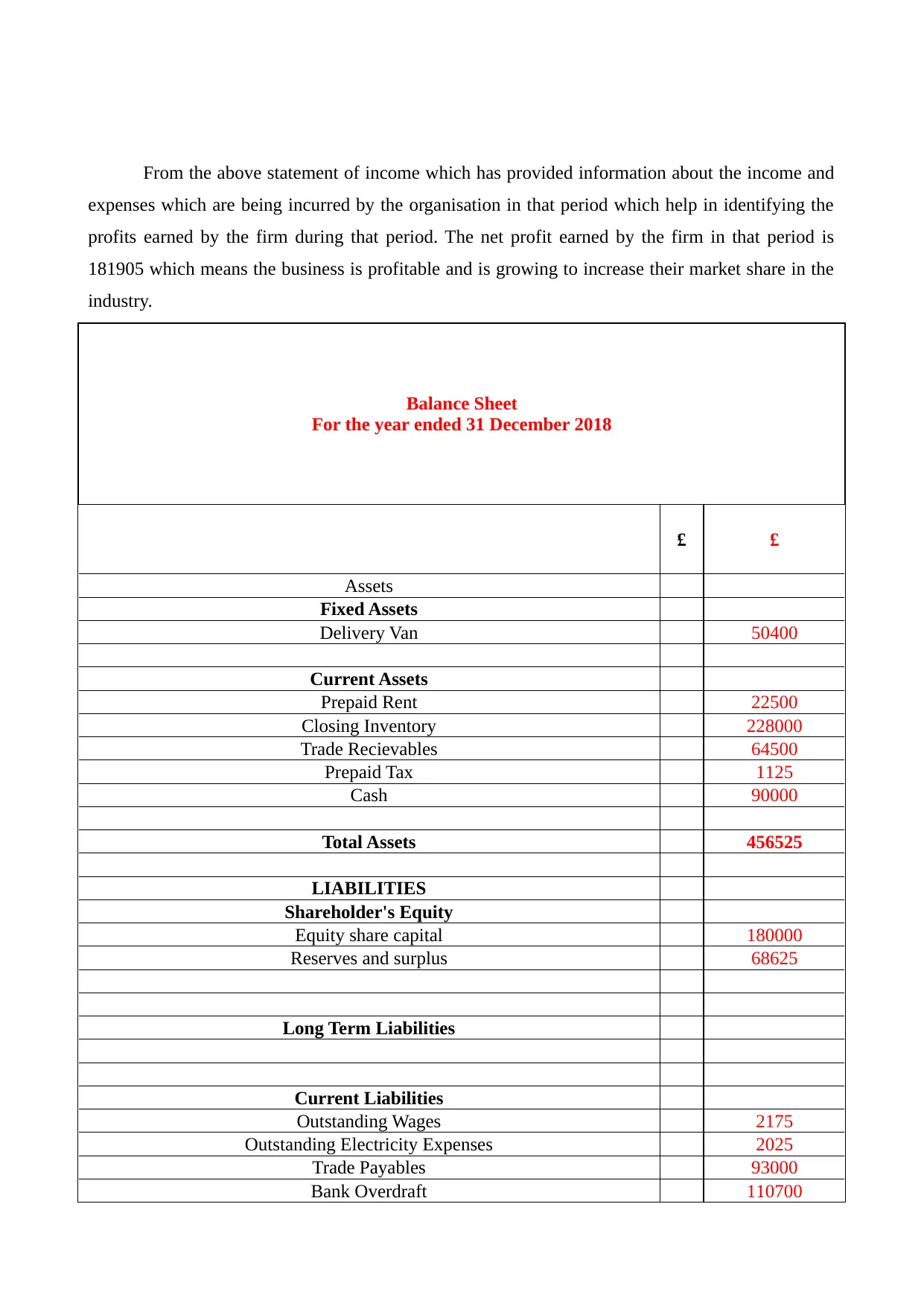
From the above statement of income which has provided information about the income and
expenses which are being incurred by the organisation in that period which help in identifying the
profits earned by the firm during that period. The net profit earned by the firm in that period is
181905 which means the business is profitable and is growing to increase their market share in the
industry.
Balance Sheet
For the year ended 31 December 2018
£ £
Assets
Fixed Assets
Delivery Van 50400
Current Assets
Prepaid Rent 22500
Closing Inventory 228000
Trade Recievables 64500
Prepaid Tax 1125
Cash 90000
Total Assets 456525
LIABILITIES
Shareholder's Equity
Equity share capital 180000
Reserves and surplus 68625
Long Term Liabilities
Current Liabilities
Outstanding Wages 2175
Outstanding Electricity Expenses 2025
Trade Payables 93000
Bank Overdraft 110700
expenses which are being incurred by the organisation in that period which help in identifying the
profits earned by the firm during that period. The net profit earned by the firm in that period is
181905 which means the business is profitable and is growing to increase their market share in the
industry.
Balance Sheet
For the year ended 31 December 2018
£ £
Assets
Fixed Assets
Delivery Van 50400
Current Assets
Prepaid Rent 22500
Closing Inventory 228000
Trade Recievables 64500
Prepaid Tax 1125
Cash 90000
Total Assets 456525
LIABILITIES
Shareholder's Equity
Equity share capital 180000
Reserves and surplus 68625
Long Term Liabilities
Current Liabilities
Outstanding Wages 2175
Outstanding Electricity Expenses 2025
Trade Payables 93000
Bank Overdraft 110700
Paraphrase This Document
Need a fresh take? Get an instant paraphrase of this document with our AI Paraphraser
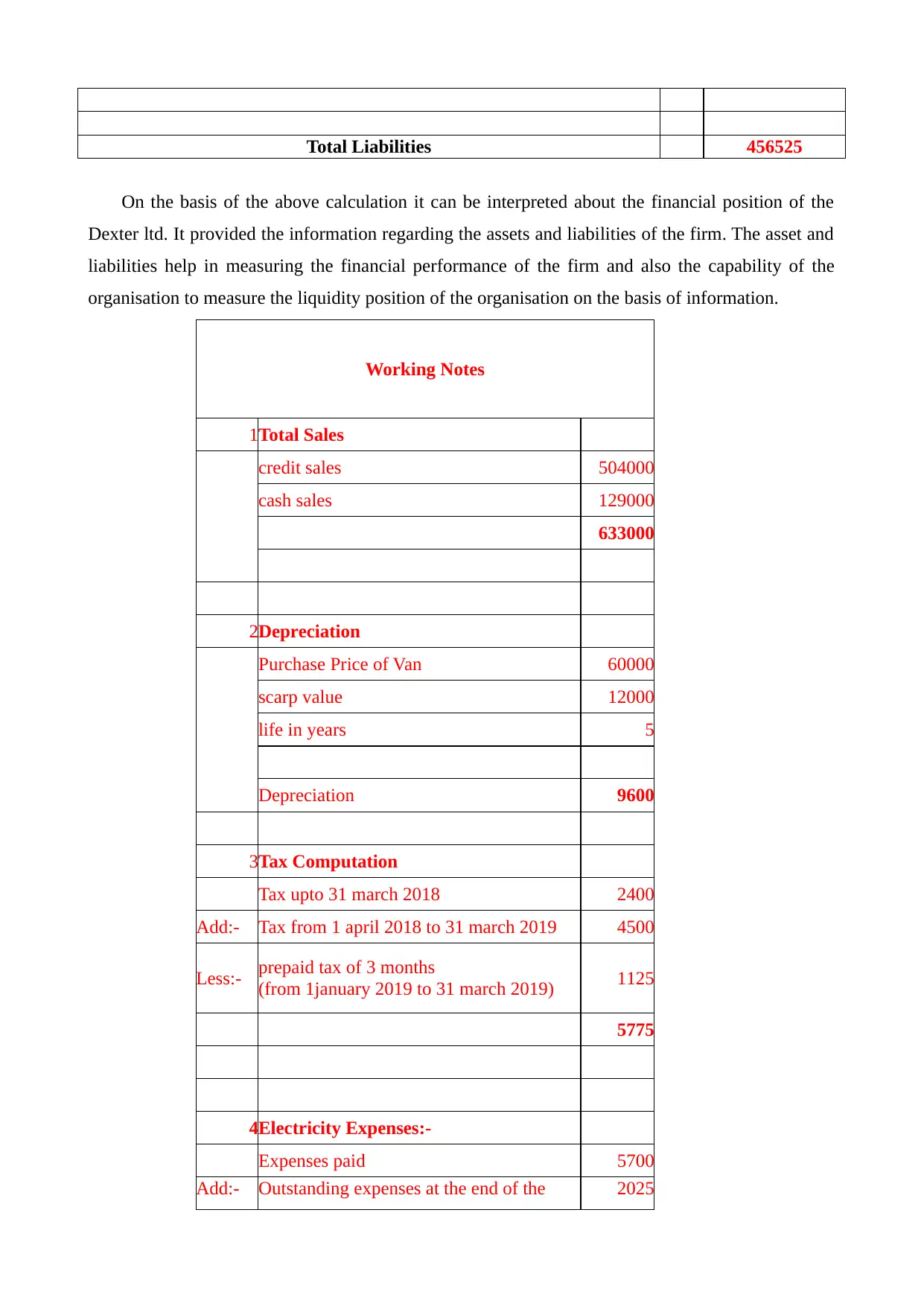
Total Liabilities 456525
On the basis of the above calculation it can be interpreted about the financial position of the
Dexter ltd. It provided the information regarding the assets and liabilities of the firm. The asset and
liabilities help in measuring the financial performance of the firm and also the capability of the
organisation to measure the liquidity position of the organisation on the basis of information.
Working Notes
1Total Sales
credit sales 504000
cash sales 129000
633000
2Depreciation
Purchase Price of Van 60000
scarp value 12000
life in years 5
Depreciation 9600
3Tax Computation
Tax upto 31 march 2018 2400
Add:- Tax from 1 april 2018 to 31 march 2019 4500
Less:- prepaid tax of 3 months
(from 1january 2019 to 31 march 2019) 1125
5775
4Electricity Expenses:-
Expenses paid 5700
Add:- Outstanding expenses at the end of the 2025
On the basis of the above calculation it can be interpreted about the financial position of the
Dexter ltd. It provided the information regarding the assets and liabilities of the firm. The asset and
liabilities help in measuring the financial performance of the firm and also the capability of the
organisation to measure the liquidity position of the organisation on the basis of information.
Working Notes
1Total Sales
credit sales 504000
cash sales 129000
633000
2Depreciation
Purchase Price of Van 60000
scarp value 12000
life in years 5
Depreciation 9600
3Tax Computation
Tax upto 31 march 2018 2400
Add:- Tax from 1 april 2018 to 31 march 2019 4500
Less:- prepaid tax of 3 months
(from 1january 2019 to 31 march 2019) 1125
5775
4Electricity Expenses:-
Expenses paid 5700
Add:- Outstanding expenses at the end of the 2025
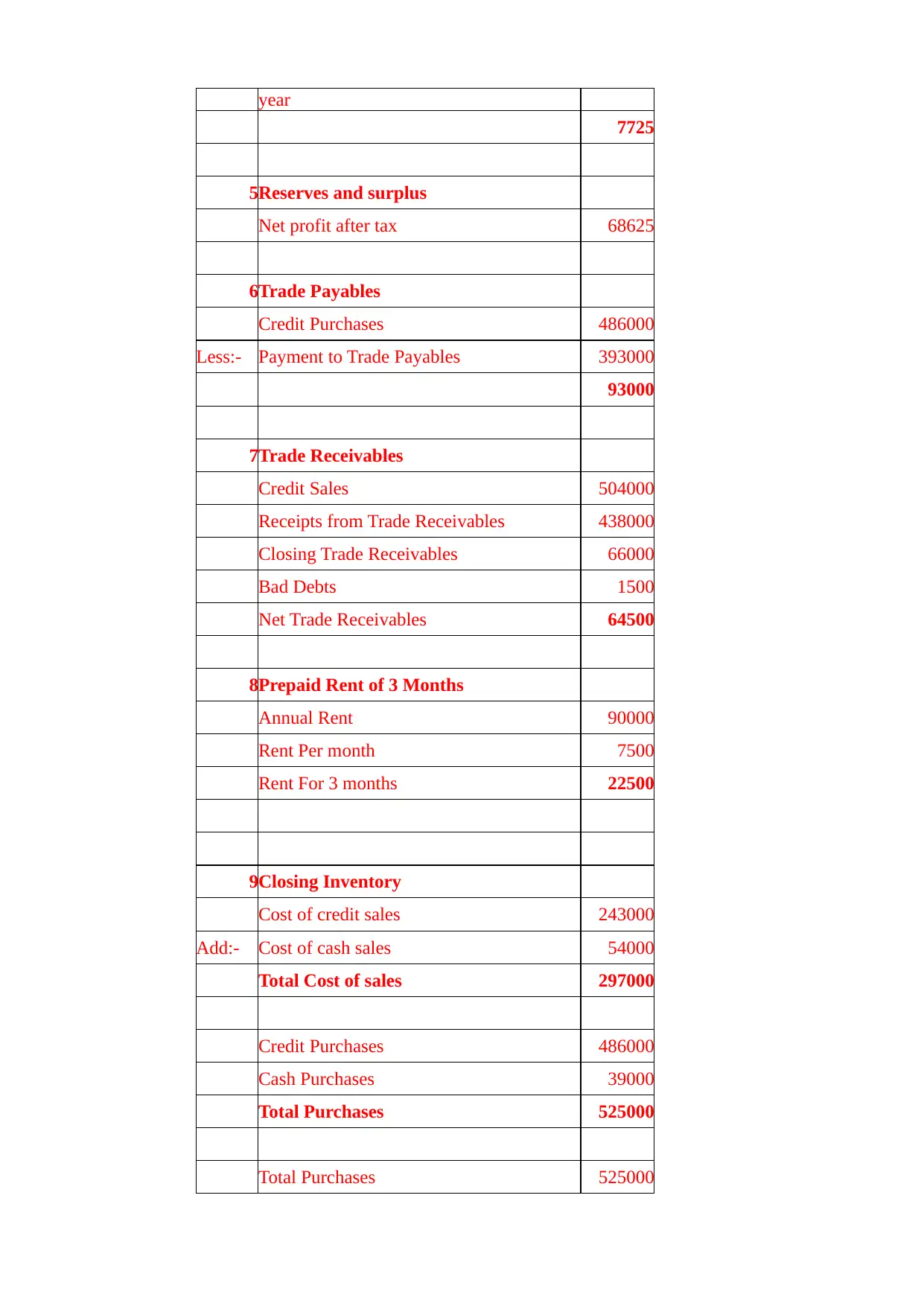
year
7725
5Reserves and surplus
Net profit after tax 68625
6Trade Payables
Credit Purchases 486000
Less:- Payment to Trade Payables 393000
93000
7Trade Receivables
Credit Sales 504000
Receipts from Trade Receivables 438000
Closing Trade Receivables 66000
Bad Debts 1500
Net Trade Receivables 64500
8Prepaid Rent of 3 Months
Annual Rent 90000
Rent Per month 7500
Rent For 3 months 22500
9Closing Inventory
Cost of credit sales 243000
Add:- Cost of cash sales 54000
Total Cost of sales 297000
Credit Purchases 486000
Cash Purchases 39000
Total Purchases 525000
Total Purchases 525000
7725
5Reserves and surplus
Net profit after tax 68625
6Trade Payables
Credit Purchases 486000
Less:- Payment to Trade Payables 393000
93000
7Trade Receivables
Credit Sales 504000
Receipts from Trade Receivables 438000
Closing Trade Receivables 66000
Bad Debts 1500
Net Trade Receivables 64500
8Prepaid Rent of 3 Months
Annual Rent 90000
Rent Per month 7500
Rent For 3 months 22500
9Closing Inventory
Cost of credit sales 243000
Add:- Cost of cash sales 54000
Total Cost of sales 297000
Credit Purchases 486000
Cash Purchases 39000
Total Purchases 525000
Total Purchases 525000
⊘ This is a preview!⊘
Do you want full access?
Subscribe today to unlock all pages.

Trusted by 1+ million students worldwide
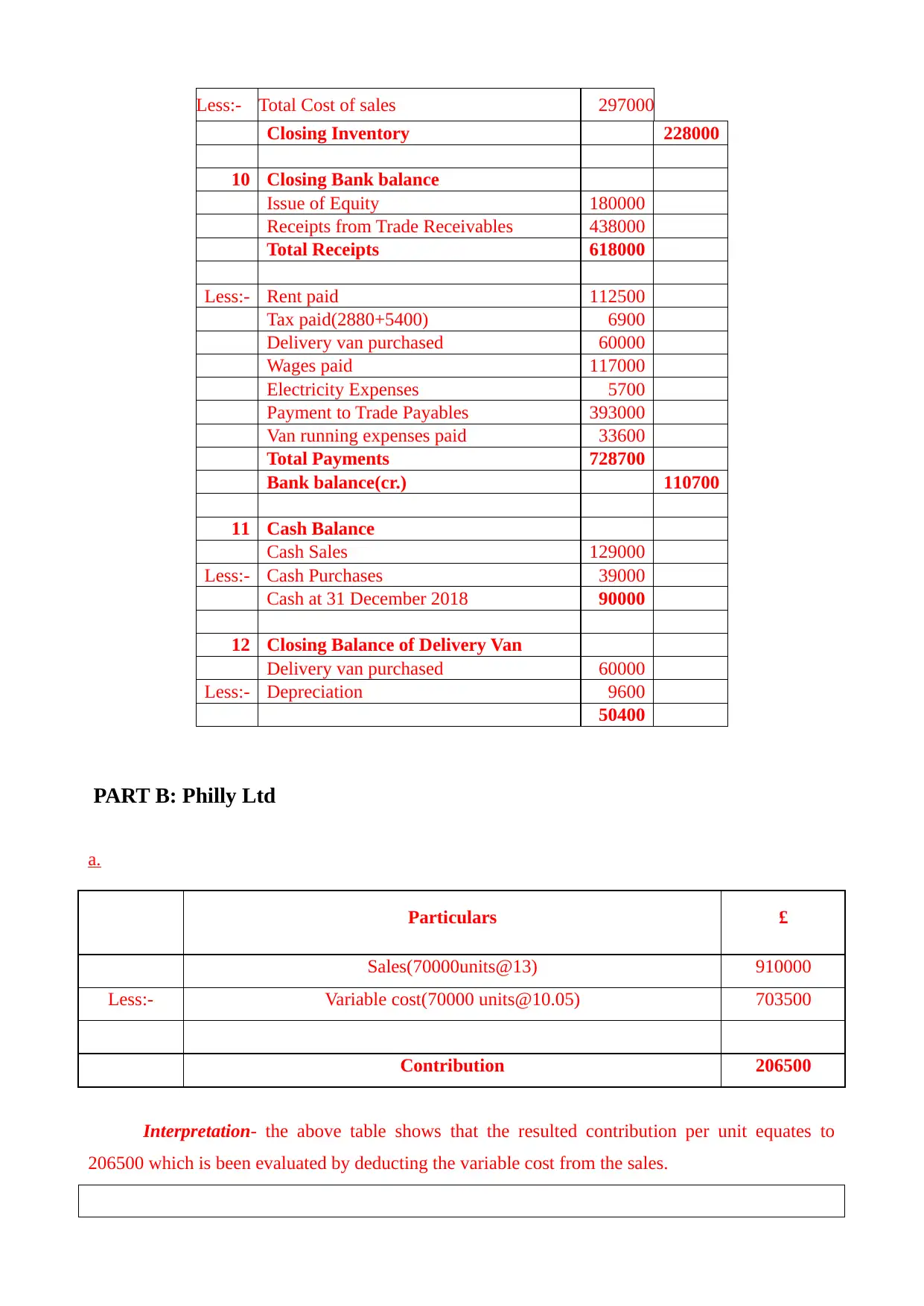
Less:- Total Cost of sales 297000
Closing Inventory 228000
10 Closing Bank balance
Issue of Equity 180000
Receipts from Trade Receivables 438000
Total Receipts 618000
Less:- Rent paid 112500
Tax paid(2880+5400) 6900
Delivery van purchased 60000
Wages paid 117000
Electricity Expenses 5700
Payment to Trade Payables 393000
Van running expenses paid 33600
Total Payments 728700
Bank balance(cr.) 110700
11 Cash Balance
Cash Sales 129000
Less:- Cash Purchases 39000
Cash at 31 December 2018 90000
12 Closing Balance of Delivery Van
Delivery van purchased 60000
Less:- Depreciation 9600
50400
PART B: Philly Ltd
a.
Particulars £
Sales(70000units@13) 910000
Less:- Variable cost(70000 units@10.05) 703500
Contribution 206500
Interpretation- the above table shows that the resulted contribution per unit equates to
206500 which is been evaluated by deducting the variable cost from the sales.
Closing Inventory 228000
10 Closing Bank balance
Issue of Equity 180000
Receipts from Trade Receivables 438000
Total Receipts 618000
Less:- Rent paid 112500
Tax paid(2880+5400) 6900
Delivery van purchased 60000
Wages paid 117000
Electricity Expenses 5700
Payment to Trade Payables 393000
Van running expenses paid 33600
Total Payments 728700
Bank balance(cr.) 110700
11 Cash Balance
Cash Sales 129000
Less:- Cash Purchases 39000
Cash at 31 December 2018 90000
12 Closing Balance of Delivery Van
Delivery van purchased 60000
Less:- Depreciation 9600
50400
PART B: Philly Ltd
a.
Particulars £
Sales(70000units@13) 910000
Less:- Variable cost(70000 units@10.05) 703500
Contribution 206500
Interpretation- the above table shows that the resulted contribution per unit equates to
206500 which is been evaluated by deducting the variable cost from the sales.
Paraphrase This Document
Need a fresh take? Get an instant paraphrase of this document with our AI Paraphraser
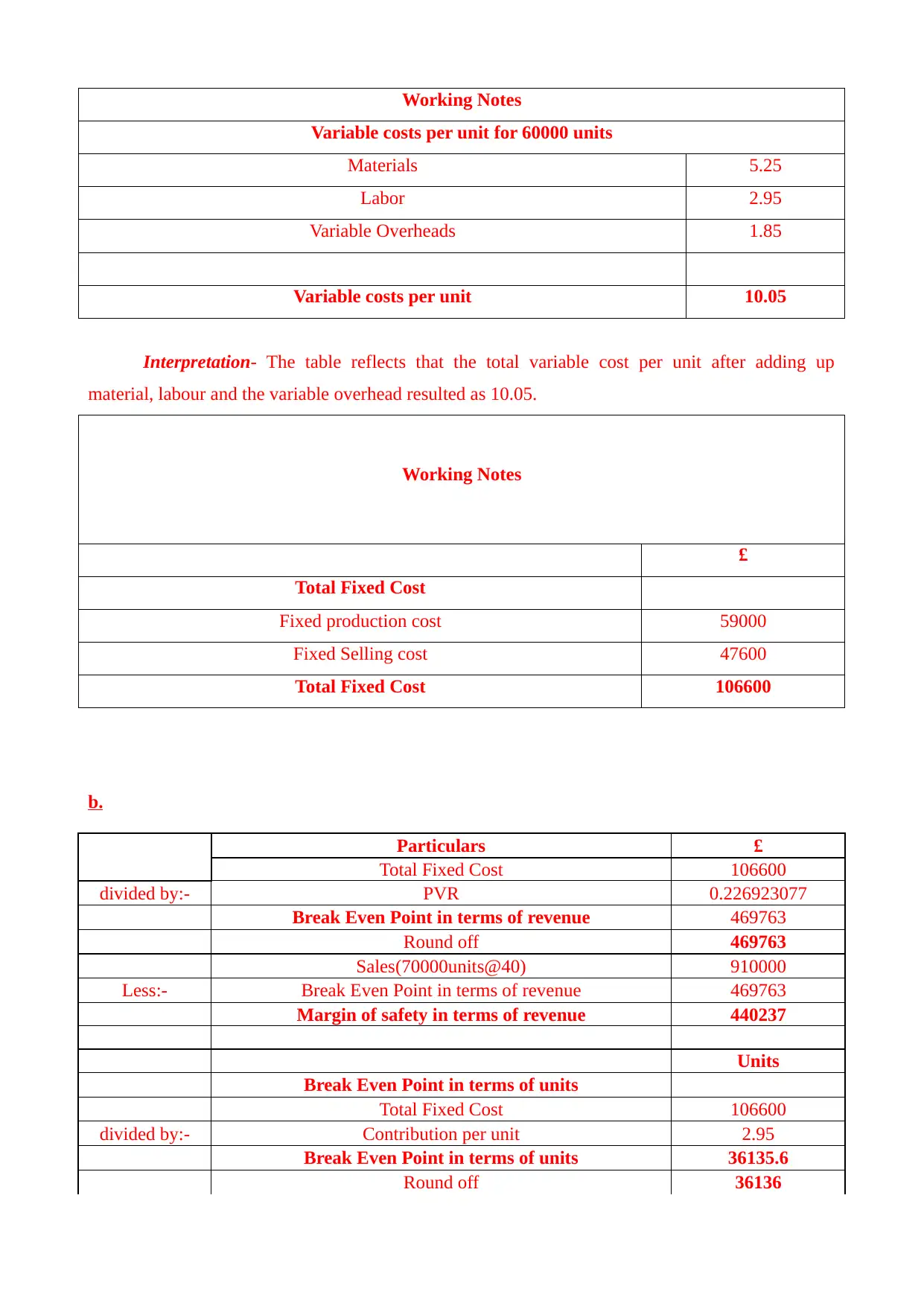
Working Notes
Variable costs per unit for 60000 units
Materials 5.25
Labor 2.95
Variable Overheads 1.85
Variable costs per unit 10.05
Interpretation- The table reflects that the total variable cost per unit after adding up
material, labour and the variable overhead resulted as 10.05.
Working Notes
£
Total Fixed Cost
Fixed production cost 59000
Fixed Selling cost 47600
Total Fixed Cost 106600
b.
Particulars £
Total Fixed Cost 106600
divided by:- PVR 0.226923077
Break Even Point in terms of revenue 469763
Round off 469763
Sales(70000units@40) 910000
Less:- Break Even Point in terms of revenue 469763
Margin of safety in terms of revenue 440237
Units
Break Even Point in terms of units
Total Fixed Cost 106600
divided by:- Contribution per unit 2.95
Break Even Point in terms of units 36135.6
Round off 36136
Variable costs per unit for 60000 units
Materials 5.25
Labor 2.95
Variable Overheads 1.85
Variable costs per unit 10.05
Interpretation- The table reflects that the total variable cost per unit after adding up
material, labour and the variable overhead resulted as 10.05.
Working Notes
£
Total Fixed Cost
Fixed production cost 59000
Fixed Selling cost 47600
Total Fixed Cost 106600
b.
Particulars £
Total Fixed Cost 106600
divided by:- PVR 0.226923077
Break Even Point in terms of revenue 469763
Round off 469763
Sales(70000units@40) 910000
Less:- Break Even Point in terms of revenue 469763
Margin of safety in terms of revenue 440237
Units
Break Even Point in terms of units
Total Fixed Cost 106600
divided by:- Contribution per unit 2.95
Break Even Point in terms of units 36135.6
Round off 36136
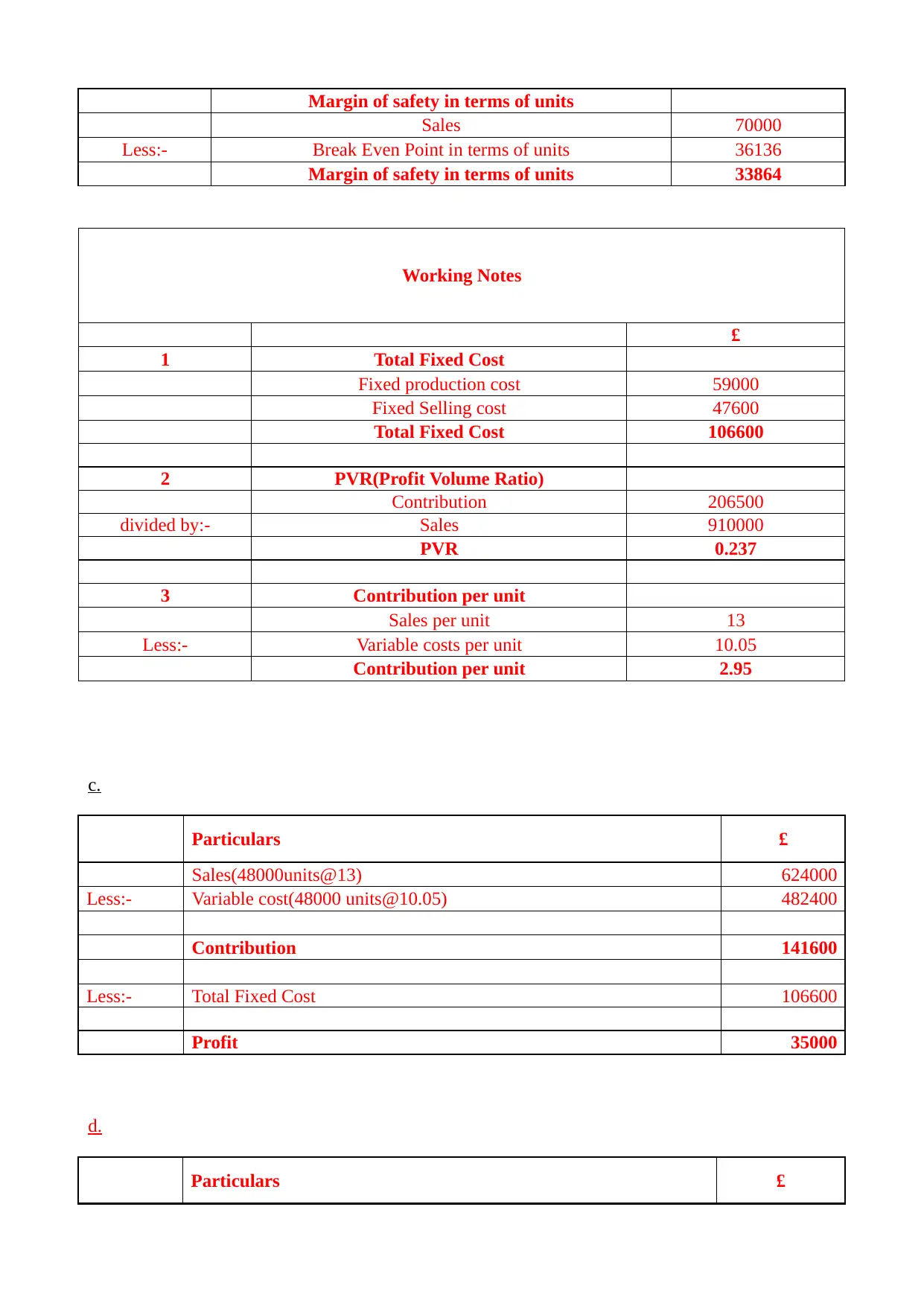
Margin of safety in terms of units
Sales 70000
Less:- Break Even Point in terms of units 36136
Margin of safety in terms of units 33864
Working Notes
£
1 Total Fixed Cost
Fixed production cost 59000
Fixed Selling cost 47600
Total Fixed Cost 106600
2 PVR(Profit Volume Ratio)
Contribution 206500
divided by:- Sales 910000
PVR 0.237
3 Contribution per unit
Sales per unit 13
Less:- Variable costs per unit 10.05
Contribution per unit 2.95
c.
Particulars £
Sales(48000units@13) 624000
Less:- Variable cost(48000 units@10.05) 482400
Contribution 141600
Less:- Total Fixed Cost 106600
Profit 35000
d.
Particulars £
Sales 70000
Less:- Break Even Point in terms of units 36136
Margin of safety in terms of units 33864
Working Notes
£
1 Total Fixed Cost
Fixed production cost 59000
Fixed Selling cost 47600
Total Fixed Cost 106600
2 PVR(Profit Volume Ratio)
Contribution 206500
divided by:- Sales 910000
PVR 0.237
3 Contribution per unit
Sales per unit 13
Less:- Variable costs per unit 10.05
Contribution per unit 2.95
c.
Particulars £
Sales(48000units@13) 624000
Less:- Variable cost(48000 units@10.05) 482400
Contribution 141600
Less:- Total Fixed Cost 106600
Profit 35000
d.
Particulars £
⊘ This is a preview!⊘
Do you want full access?
Subscribe today to unlock all pages.

Trusted by 1+ million students worldwide
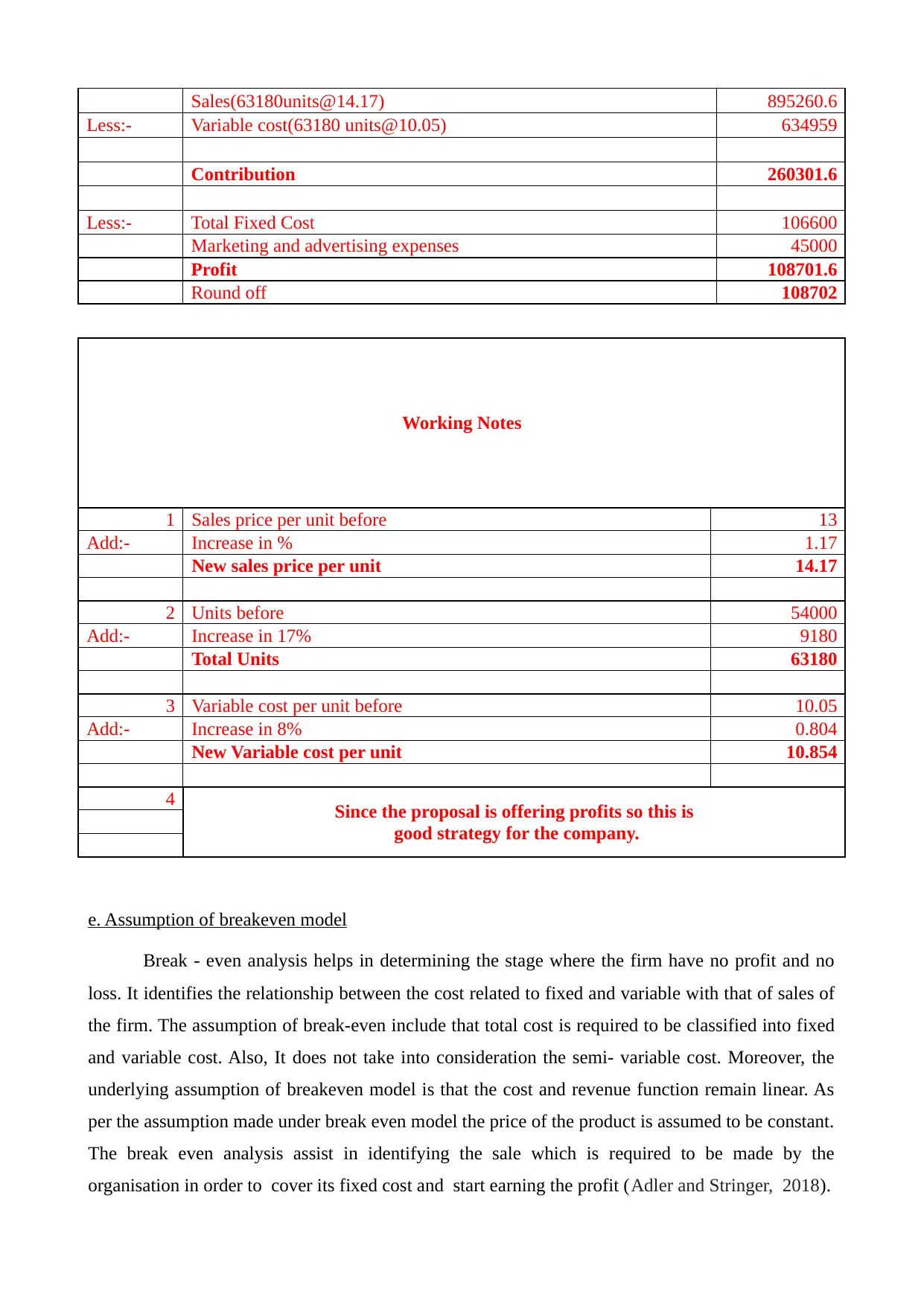
Sales(63180units@14.17) 895260.6
Less:- Variable cost(63180 units@10.05) 634959
Contribution 260301.6
Less:- Total Fixed Cost 106600
Marketing and advertising expenses 45000
Profit 108701.6
Round off 108702
Working Notes
1 Sales price per unit before 13
Add:- Increase in % 1.17
New sales price per unit 14.17
2 Units before 54000
Add:- Increase in 17% 9180
Total Units 63180
3 Variable cost per unit before 10.05
Add:- Increase in 8% 0.804
New Variable cost per unit 10.854
4 Since the proposal is offering profits so this is
good strategy for the company.
e. Assumption of breakeven model
Break - even analysis helps in determining the stage where the firm have no profit and no
loss. It identifies the relationship between the cost related to fixed and variable with that of sales of
the firm. The assumption of break-even include that total cost is required to be classified into fixed
and variable cost. Also, It does not take into consideration the semi- variable cost. Moreover, the
underlying assumption of breakeven model is that the cost and revenue function remain linear. As
per the assumption made under break even model the price of the product is assumed to be constant.
The break even analysis assist in identifying the sale which is required to be made by the
organisation in order to cover its fixed cost and start earning the profit (Adler and Stringer, 2018).
Less:- Variable cost(63180 units@10.05) 634959
Contribution 260301.6
Less:- Total Fixed Cost 106600
Marketing and advertising expenses 45000
Profit 108701.6
Round off 108702
Working Notes
1 Sales price per unit before 13
Add:- Increase in % 1.17
New sales price per unit 14.17
2 Units before 54000
Add:- Increase in 17% 9180
Total Units 63180
3 Variable cost per unit before 10.05
Add:- Increase in 8% 0.804
New Variable cost per unit 10.854
4 Since the proposal is offering profits so this is
good strategy for the company.
e. Assumption of breakeven model
Break - even analysis helps in determining the stage where the firm have no profit and no
loss. It identifies the relationship between the cost related to fixed and variable with that of sales of
the firm. The assumption of break-even include that total cost is required to be classified into fixed
and variable cost. Also, It does not take into consideration the semi- variable cost. Moreover, the
underlying assumption of breakeven model is that the cost and revenue function remain linear. As
per the assumption made under break even model the price of the product is assumed to be constant.
The break even analysis assist in identifying the sale which is required to be made by the
organisation in order to cover its fixed cost and start earning the profit (Adler and Stringer, 2018).
Paraphrase This Document
Need a fresh take? Get an instant paraphrase of this document with our AI Paraphraser
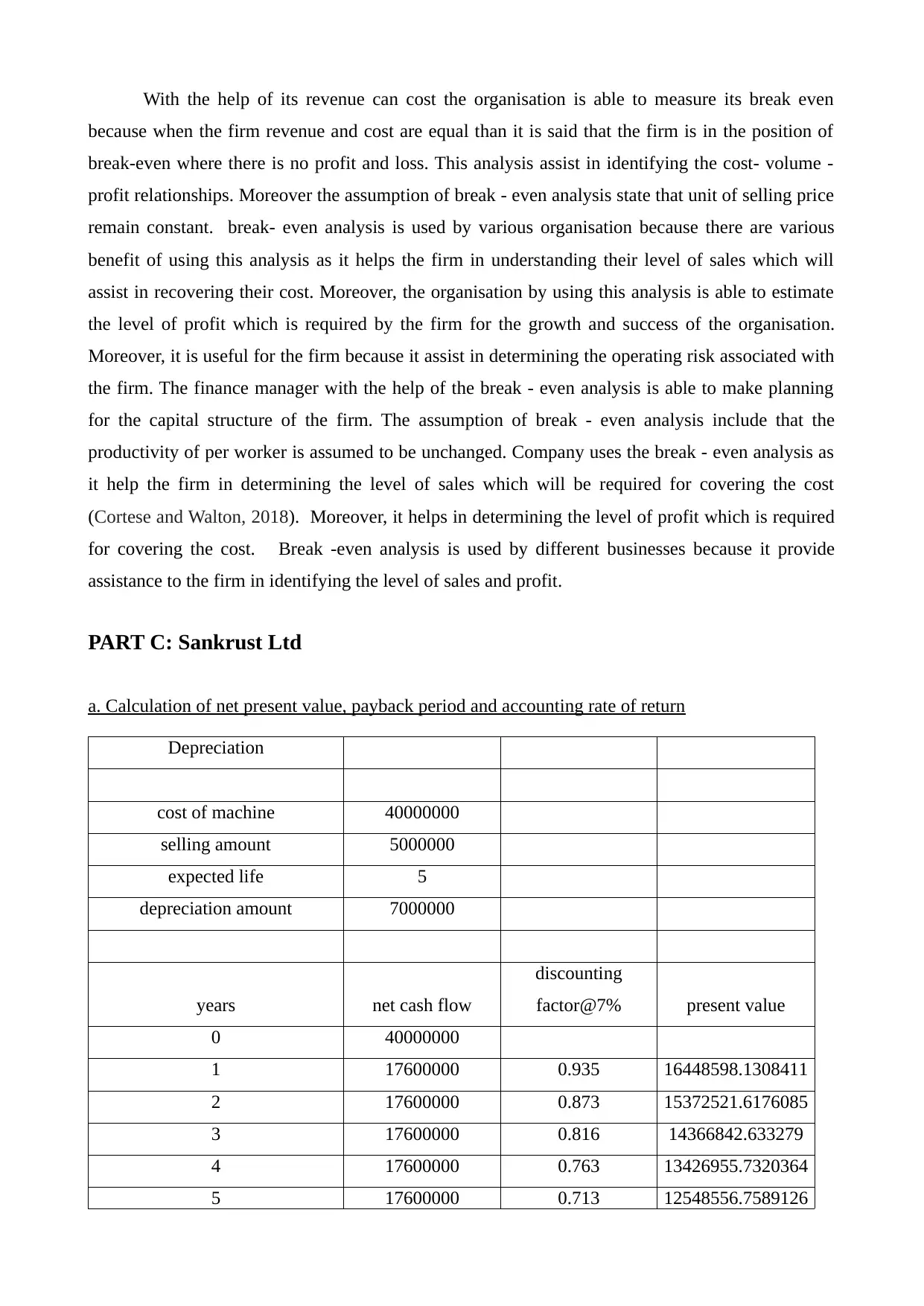
With the help of its revenue can cost the organisation is able to measure its break even
because when the firm revenue and cost are equal than it is said that the firm is in the position of
break-even where there is no profit and loss. This analysis assist in identifying the cost- volume -
profit relationships. Moreover the assumption of break - even analysis state that unit of selling price
remain constant. break- even analysis is used by various organisation because there are various
benefit of using this analysis as it helps the firm in understanding their level of sales which will
assist in recovering their cost. Moreover, the organisation by using this analysis is able to estimate
the level of profit which is required by the firm for the growth and success of the organisation.
Moreover, it is useful for the firm because it assist in determining the operating risk associated with
the firm. The finance manager with the help of the break - even analysis is able to make planning
for the capital structure of the firm. The assumption of break - even analysis include that the
productivity of per worker is assumed to be unchanged. Company uses the break - even analysis as
it help the firm in determining the level of sales which will be required for covering the cost
(Cortese and Walton, 2018). Moreover, it helps in determining the level of profit which is required
for covering the cost. Break -even analysis is used by different businesses because it provide
assistance to the firm in identifying the level of sales and profit.
PART C: Sankrust Ltd
a. Calculation of net present value, payback period and accounting rate of return
Depreciation
cost of machine 40000000
selling amount 5000000
expected life 5
depreciation amount 7000000
years net cash flow
discounting
factor@7% present value
0 40000000
1 17600000 0.935 16448598.1308411
2 17600000 0.873 15372521.6176085
3 17600000 0.816 14366842.633279
4 17600000 0.763 13426955.7320364
5 17600000 0.713 12548556.7589126
because when the firm revenue and cost are equal than it is said that the firm is in the position of
break-even where there is no profit and loss. This analysis assist in identifying the cost- volume -
profit relationships. Moreover the assumption of break - even analysis state that unit of selling price
remain constant. break- even analysis is used by various organisation because there are various
benefit of using this analysis as it helps the firm in understanding their level of sales which will
assist in recovering their cost. Moreover, the organisation by using this analysis is able to estimate
the level of profit which is required by the firm for the growth and success of the organisation.
Moreover, it is useful for the firm because it assist in determining the operating risk associated with
the firm. The finance manager with the help of the break - even analysis is able to make planning
for the capital structure of the firm. The assumption of break - even analysis include that the
productivity of per worker is assumed to be unchanged. Company uses the break - even analysis as
it help the firm in determining the level of sales which will be required for covering the cost
(Cortese and Walton, 2018). Moreover, it helps in determining the level of profit which is required
for covering the cost. Break -even analysis is used by different businesses because it provide
assistance to the firm in identifying the level of sales and profit.
PART C: Sankrust Ltd
a. Calculation of net present value, payback period and accounting rate of return
Depreciation
cost of machine 40000000
selling amount 5000000
expected life 5
depreciation amount 7000000
years net cash flow
discounting
factor@7% present value
0 40000000
1 17600000 0.935 16448598.1308411
2 17600000 0.873 15372521.6176085
3 17600000 0.816 14366842.633279
4 17600000 0.763 13426955.7320364
5 17600000 0.713 12548556.7589126
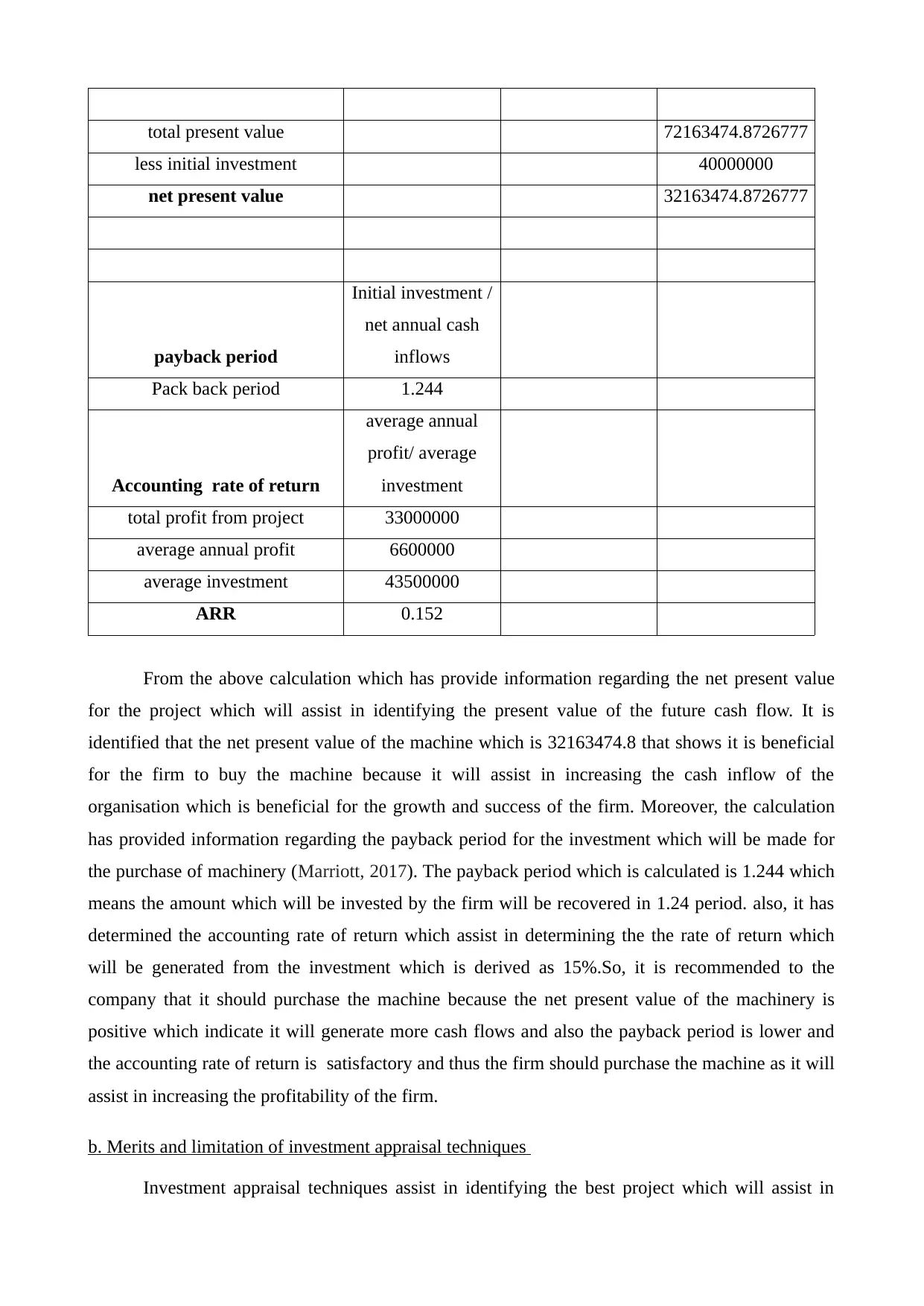
total present value 72163474.8726777
less initial investment 40000000
net present value 32163474.8726777
payback period
Initial investment /
net annual cash
inflows
Pack back period 1.244
Accounting rate of return
average annual
profit/ average
investment
total profit from project 33000000
average annual profit 6600000
average investment 43500000
ARR 0.152
From the above calculation which has provide information regarding the net present value
for the project which will assist in identifying the present value of the future cash flow. It is
identified that the net present value of the machine which is 32163474.8 that shows it is beneficial
for the firm to buy the machine because it will assist in increasing the cash inflow of the
organisation which is beneficial for the growth and success of the firm. Moreover, the calculation
has provided information regarding the payback period for the investment which will be made for
the purchase of machinery (Marriott, 2017). The payback period which is calculated is 1.244 which
means the amount which will be invested by the firm will be recovered in 1.24 period. also, it has
determined the accounting rate of return which assist in determining the the rate of return which
will be generated from the investment which is derived as 15%.So, it is recommended to the
company that it should purchase the machine because the net present value of the machinery is
positive which indicate it will generate more cash flows and also the payback period is lower and
the accounting rate of return is satisfactory and thus the firm should purchase the machine as it will
assist in increasing the profitability of the firm.
b. Merits and limitation of investment appraisal techniques
Investment appraisal techniques assist in identifying the best project which will assist in
less initial investment 40000000
net present value 32163474.8726777
payback period
Initial investment /
net annual cash
inflows
Pack back period 1.244
Accounting rate of return
average annual
profit/ average
investment
total profit from project 33000000
average annual profit 6600000
average investment 43500000
ARR 0.152
From the above calculation which has provide information regarding the net present value
for the project which will assist in identifying the present value of the future cash flow. It is
identified that the net present value of the machine which is 32163474.8 that shows it is beneficial
for the firm to buy the machine because it will assist in increasing the cash inflow of the
organisation which is beneficial for the growth and success of the firm. Moreover, the calculation
has provided information regarding the payback period for the investment which will be made for
the purchase of machinery (Marriott, 2017). The payback period which is calculated is 1.244 which
means the amount which will be invested by the firm will be recovered in 1.24 period. also, it has
determined the accounting rate of return which assist in determining the the rate of return which
will be generated from the investment which is derived as 15%.So, it is recommended to the
company that it should purchase the machine because the net present value of the machinery is
positive which indicate it will generate more cash flows and also the payback period is lower and
the accounting rate of return is satisfactory and thus the firm should purchase the machine as it will
assist in increasing the profitability of the firm.
b. Merits and limitation of investment appraisal techniques
Investment appraisal techniques assist in identifying the best project which will assist in
⊘ This is a preview!⊘
Do you want full access?
Subscribe today to unlock all pages.

Trusted by 1+ million students worldwide
1 out of 18
Related Documents
Your All-in-One AI-Powered Toolkit for Academic Success.
+13062052269
info@desklib.com
Available 24*7 on WhatsApp / Email
![[object Object]](/_next/static/media/star-bottom.7253800d.svg)
Unlock your academic potential
Copyright © 2020–2025 A2Z Services. All Rights Reserved. Developed and managed by ZUCOL.



